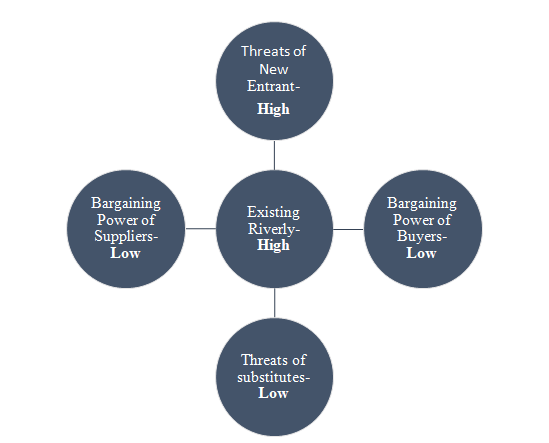CAR WASH & AUTO DETAILING IN CANADA Case Study Help
Porter Five Forces Analysis
1. Competition in the Industry:
In Canada, the carwash and auto detailing industry confronts high and stable competition. However, this industry has only one major player, who runs two hundred and fifty stations for carwash services.In addition, it comprises of a large number of small-scale operators based on local and regional levels. The market share concentration is low due to none ofthe other operators reporting more than 5% revenue in the industry. The barrier for new entrants is low in this Canadianindustry.
To attract the new customers; industry operators usually compete with value services, prices, promotions offer, couponsand discounts. The carwash industry in Canada has designed wash cards that offer volume-based discounts and other benefits to the existing customers in order to make them regular customers. Services differ from automatic car washes to self-service car washes. The new operatorscan distinguish themselves from proposing additional valuable services, including: changing of oil and lubricants. On the other hand, the secret of successful car wash companies is that they are often located in high-traffic volume areas, where a large number of cars pass by.
- Threats of New Entrant:
In Canada, the carwash industry hashigh threats of new entrants, as there is only one prime playerthat acquiresa market share of 7.3%: Petro-Canada. The company operates full-gas stations and provides various services in high-traffic locations. Other than that, small-scale and medium-scale establishments are also present in the competition.The capital requirement of self-service car wash stations is lowest, because it requiresless equipment, such as: sufficient space for vehicles, water, detergents and vacuums. As this industry is highly competitive, most of which are small and large size of enterprises.New entrants need to focus on marketing in order to achieve a new customer segment.
- Bargaining Power of Buyers:
The buyers in the carwash and auto detailing industry are classified into three categories, which are:individuals, businesses and government& nonprofit organizations. The bargaining power of buyers is low, due to the lack of substitute companies in the market. Low-income individual switching cost is high as compared to high-income individuals. Buyers comprise the increase of large portion sales to carwash companies in the market. Buyers are not price-sensitive, because individuals with high income generally spend high-priced car washing and detailing services, and individuals with low income opt for low-priced self-services.
- Bargaining Power of Suppliers:
The suppliers are categories as of 1st tier and 2nd tier in carwash and auto detailing industry in Canada. The bargaining power of suppliers is low due to enlarge number of suppliers available in the market. Most of the suppliers are small players and very few of them are outstanding in size. IN the carwash industry; the materials used in the services are widely available and have several substitutes according to price and quality. The suppliers of carwash material don’t pose any threat of forwarding an integration in the market.
Threats of substitutes:
In terms of the carwash services industry; it can be said that the general need of its customer is car services. It may be clear that there are various services according to different categories of customers. Depending upon customers’ preferences and their budgets; high income generating customers prefer detailed and automated carwash services, where a slow income generating customers opt for self-service facilities. Therefore, the threat of substitutes is low in the Canadian carwash industry. It is so, because there are no alternatives for customers to choose from, except availing the car wash service, mobile carwash and washing their cars themselves..................

This is just a sample partial case solution. Please place the order on the website to order your own originally done case solution.













